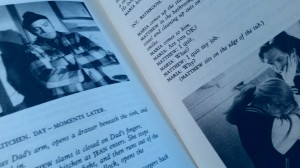 In broad strokes, Hal Hartley’s 1990 film Trust looks like melodrama—Maria, a pregnant seventeen-year-old, is dumped by her boyfriend. Her future love interest, Matthew, lives with his physically and mentally abusive father, meek at home but volatile and violent out in the world. There are multiple fistfights and a stolen baby.
In broad strokes, Hal Hartley’s 1990 film Trust looks like melodrama—Maria, a pregnant seventeen-year-old, is dumped by her boyfriend. Her future love interest, Matthew, lives with his physically and mentally abusive father, meek at home but volatile and violent out in the world. There are multiple fistfights and a stolen baby.
Melodrama tends towards stereotypes, but Hartley subverts expected outcomes. Following Matthew’s impulsive marriage proposal, instead of Maria’s happy acceptance or crushing refusal, we get a decidedly unmelodramatic conversation about the definition of love. Maria asks Matthew why he would want to marry her. (She is, after all, melodramatically carrying someone else’s child.)
MATTHEW: Because I want to.
MARIA: Not because you love me or anything like that, huh?
MATTHEW: I respect and admire you.
MARIA: Isn’t that love?
MATTHEW: No, that’s respect and admiration.
When I first saw Trust, the film felt both familiar and like nothing I had ever seen. I loved the shot composition, the palette of blues and grays, the soundtrack. But more than anything, I loved the dialogue. Perhaps I was connecting it to other films I loved; the deadpan delivery and comedic timing of Golden Age screwball comedies like The Philadelphia Story and classic noir like The Maltese Falcon were here brought into a contemporary setting. After Matthew returns to a job he hates (to get benefits for Maria and the baby), she finds him watching TV, something he never does.
MARIA: Can you stop watching TV for a moment?
MATTHEW: No.
MARIA: Why?
MATTHEW: I had a bad day. I had to subvert my principles and kowtow to an idiot. Television makes these daily sacrifices possible. It deadens the inner core of my being.
MARIA: Let’s move away, then.
MATTHEW: They have television everywhere. There’s no escape. [. . .]
MATTHEW: I’m just trying to be practical. Levelheaded.
MARIA: What’s so practical about being levelheaded?
Also like many masterpieces of screwball comedy and noir, Trust (as well as most of Hartley’s films) conveys multiple tones at once, forming unexpected chords. The movie is both serious and funny, often at the same time. When Matthew’s intense father tracks him down at Maria’s house, their conversation escalates into a fistfight. Matthew, never before able to stand up to his father, now pushes back. The resulting fight is cathartic, and yet Hartley also combines elements of slapstick—a head slammed in by the refrigerator door, a hand crushed in a drawer—both funny and flinch-inducing.
Later in the movie, Maria tells another character she likes Matthew the way he is: “Dangerous. But sincere.” The woman replies, “Sincerely dangerous,” but Maria counters with this remarkable line: “No, dangerous because he’s sincere.” This may have been what I was really tapping into twenty years ago when I first saw Trust. Just as the snappy comebacks of Katharine Hepburn and Humphrey Bogart mixed the jaded with the sincere, Hartley showed me that dialogue could be funny, dark, and smart while also being heartfelt. Sincerity isn’t melodrama. As a writer in a culture that often defaults to flimsy irony, I still need to remember this.
Stacey Swann’s fiction has appeared in Epoch, Memorious, Versal, and other journals. A former Stegner Fellow, she teaches with Stanford University’s Online Writer’s Studio.
NER Digital is New England Review’s online project dedicated to original creative writing for the web. “Confluences” presents writers’ encounters with works of art such as books, plays, poems, films, paintings, sculptures, or buildings.
*This* affirms why I have a Google alert for Hal Hartley. Excellent piece, Stacey Swann, and I really like your name.